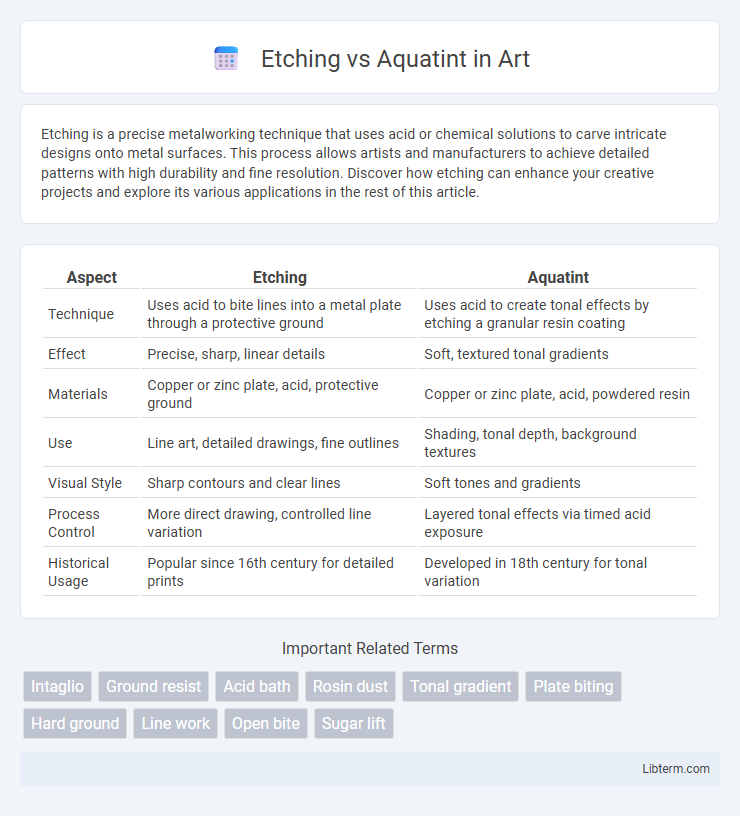Etching is a precise metalworking technique that uses acid or chemical solutions to carve intricate designs onto metal surfaces. This process allows artists and manufacturers to achieve detailed patterns with high durability and fine resolution. Discover how etching can enhance your creative projects and explore its various applications in the rest of this article.
Table of Comparison
| Aspect | Etching | Aquatint |
|---|---|---|
| Technique | Uses acid to bite lines into a metal plate through a protective ground | Uses acid to create tonal effects by etching a granular resin coating |
| Effect | Precise, sharp, linear details | Soft, textured tonal gradients |
| Materials | Copper or zinc plate, acid, protective ground | Copper or zinc plate, acid, powdered resin |
| Use | Line art, detailed drawings, fine outlines | Shading, tonal depth, background textures |
| Visual Style | Sharp contours and clear lines | Soft tones and gradients |
| Process Control | More direct drawing, controlled line variation | Layered tonal effects via timed acid exposure |
| Historical Usage | Popular since 16th century for detailed prints | Developed in 18th century for tonal variation |
Introduction to Printmaking Techniques
Etching and aquatint are foundational intaglio printmaking techniques that create distinct textural effects through acid-resistant grounds and metal plates. Etching involves using a needle to trace designs onto a wax-coated plate, which is then submerged in acid to bite the exposed lines, producing fine, detailed marks. Aquatint enhances tonal variation by applying a powdered resin to the plate, enabling artists to achieve rich gradients and shaded areas through controlled acid exposure.
Understanding Etching: Process and History
Etching, a printmaking technique dating back to the 16th century, involves using acid to carve into a metal plate, typically copper, where an artist first coats the surface with a protective ground before drawing their design. This process allows for precise lines and detailed images through controlled acid exposure, contrasting with aquatint's focus on tonal shading by creating areas of granular texture. Historically, etching gained prominence during the Renaissance, with masters like Rembrandt elevating its artistic potential through intricate line work and varied tonal effects.
Demystifying Aquatint: Method and Origins
Aquatint, developed in the 18th century by Jean-Baptiste Le Prince, employs a fine powdered resin applied to a metal plate, which is then heated to create a textured, tonal effect ideal for shading in printmaking. Unlike etching that uses line incisions to form images, aquatint enables artists to achieve a watercolor-like gradient, distinguishing it as a method for tonal variation rather than linear detail. The process involves acid biting around the resin particles, creating a granular surface that retains ink and produces nuanced shades, revolutionizing print aesthetics beyond traditional etching's linear constraints.
Key Differences Between Etching and Aquatint
Etching involves using acid to create precise lines on a metal plate by exposing it through a protective ground, while aquatint focuses on producing tonal effects by applying a powdered resin that resists acid unevenly. The key difference lies in etching's emphasis on fine, linear detail versus aquatint's ability to achieve a range of shades and textures resembling watercolor washes. Etching is ideal for detailed, crisp images, whereas aquatint enhances prints with rich tonal variations and depth.
Materials and Tools Required for Etching and Aquatint
Etching requires a copper or zinc plate, an acid-resistant ground such as wax or resin, and a metal etching needle for drawing. Aquatint uses similar plates but incorporates a powdered resin dusted onto the plate to create tonal effects and requires an aquatint box or spray for even resin application. Both techniques rely on acid baths for biting the exposed metal, with aquatint demanding precise control of resin particles to achieve gradient shading.
Artistic Effects: Tonal Range in Etching vs Aquatint
Etching produces sharp, precise lines with a limited tonal range, emphasizing strong contrasts and detailed linear textures. Aquatint excels in creating rich, gradient tonal variations, allowing artists to achieve smooth shading and depth through a powdered resin technique. The tonal range in aquatint enhances atmospheric effects, while etching highlights fine contour and intricate line work.
Durability and Edition Size Considerations
Etching plates, typically made of copper, offer high durability allowing artists to produce larger edition sizes without significant degradation in line quality. Aquatint requires a resin dust tone application, which slightly reduces plate longevity but enables rich tonal variations, often resulting in smaller edition sizes to maintain image fidelity. Both techniques demand careful plate maintenance, but etching generally supports more prints per plate before noticeable wear occurs.
Applications: When to Choose Etching or Aquatint
Etching is ideal for creating precise, intricate line work suited for detailed illustrations and fine art prints, favored by artists requiring sharp, controlled designs. Aquatint excels in producing tonal variations and textured gradients, making it suitable for atmospheric effects, landscapes, or portraits where subtle shading enhances depth. Choose etching for clarity and definition in linear compositions, while aquatint better serves works emphasizing tone and mood through nuanced shadowing.
Comparing Costs and Accessibility
Etching typically involves lower initial costs due to simpler tools like metal plates, acid, and basic etching needles, making it more accessible for beginners and hobbyists. Aquatint requires specialized powders and more precise acid bath control, which can increase expenses and complexity, often limiting accessibility to experienced printmakers or well-equipped studios. Both techniques vary in cost depending on scale and materials, but etching generally offers a more affordable entry point for artists exploring intaglio printmaking.
Conclusion: Selecting the Right Technique for Your Art
Etching offers precise lines and detailed texture ideal for intricate designs, while aquatint excels in creating tonal variations and rich shading suited for atmospheric effects. Artists should consider etching for crisp, linear work and aquatint when seeking depth through gradients and textures. Combining both techniques can enhance artistic expression by balancing detail with tonal complexity.
Etching Infographic

 libterm.com
libterm.com